Advertisements
Advertisements
प्रश्न
Write a short note on dispersion of light.
उत्तर
Dispersion of light:-
The phenomenon of splitting of light into its component colours is called dispersion of light. When white light passes through a glass prism, it spreads out into a band of different colours which constitute the spectrum of light. The colours in the spectrum of white light are violet, indigo, blue, green, yellow, orange and red. Dispersion takes place because the refractive index of a material such as glass or water is different for different colours. It is maximum for violet colour and minimum for red colour. Hence, in the spectrum of white light obtained with a prism, violet light is deviated the most, while red light is deviated the least. The deviation of light corresponding to other colours lies in between these two colours.
APPEARS IN
संबंधित प्रश्न
Define refraction and state the laws of refraction.
A student traces the path of a ray of light through a rectangular glass slab for the different values of angle of incidence. He observes all possible precautions at each step of the experiment. At the end of the experiment, on analyzing the measurements, which of the following conclusions is he likely to draw?
(A) ∠i = ∠e < ∠r
(B) ∠i < ∠e < ∠r
(C) ∠i > ∠e > ∠r
(D) ∠i = ∠e > ∠r
A ray of light passes from water to air. How does the speed of light change?
Name a prism required for obtaining a spectrum of Ultraviolet light.
Which of the above wavelengths has a higher frequency?
The following diagram shows a 60°, 30°, 90° glass prism of critical angle 42°, Copy the diagram and complete the path of incident ray AB emerging out of the prism marking the angle of incidence on each surface.

How is the refractive index of a medium related to the speed of light in it?
Light of a single colour is passed through a liquid having a piece of glass suspended in it. On changing the temperature of liquid, at a particular temperature the glass piece is not seen. When is the glass piece not seen?
When light travels from a rarer to a denser medium, its speed ______.
In fig 4.18, name the ray which represents the correct path of light while emerging out through a glass block.
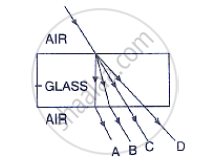
Fill in the blanks to complete the following sentence
When light travels from a denser to a rarer medium, its speed ……………….
An object is viewed through a glass prism with its vertex pointing upwards. It appears to be displaced upward. Explain the reason.
Fig 4.31 below shows a light ray of single colour incident normally on two prisms A and B. In each case draw the path of the ray of light as it enters and emerges out of the prism. Mark the angle wherever necessary.
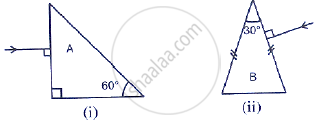
Complete Fig. 4.32 to show the path of the ray of single colour as it enters the prism and emerges out of it. Mark the angles wherever necessary.
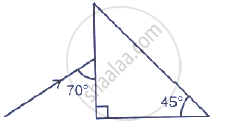
The critical angle for glass-air is 45° for the light of yellow colour. State whether it will be less than, equal to, or more than 45° for (i) ref light, (ii) blue light?
Rahim recorded the following sets of observations while tracing the path of a ray of light passing through a rectangular glass slab for different angles of incidence.
|
S. No. |
Angle of incidence |
Angle of refraction |
Angle of emergence |
|
I |
45° |
41° |
45° |
|
II |
40° |
38° |
38° |
|
III |
45° |
41° |
40° |
|
IV |
41° |
45° |
41° |
The correct observation is recorded at serial number:
(1) I
(2) II
(3) III
(4) IV
In the fig. name the ray which represents the correct path of light while passing through a glass block.
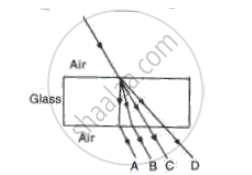
Fig shows a lens as a combination of a glass block and two prisms.
(i) Name the lens formed by the combination.
(ii) What is the line XX' called?
(iii) Complete the path of the incident ray PQ after passing through the lens.
(iv) The final emergent ray either meets XX' at a point or appears to come from a point on XX'. Label it as F, What is this point called?
Draw a diagram to show the splitting of white light into its constituent colours.
A ray of light strikes the surface at a rectangular glass slab such that the angle of incidence is 45o.
In each case, draw diagram to show the path taken by the ray as it passes through the glass slab and emerges from it.
What is meant by the refraction of light?
Why do the faces of persons sitting around campfire appear to shimmer?
Glass is transparent in nature. Why does glass powder look opaque? When water is poured over it, it again becomes transparent. Why?
A ray of light passes from water to air. How does the speed of light change?
How is the refractive index of a medium related to its real depth and apparent depth?
In what condition a prism is said to be in the position of minimum deviation? What is the direction of the refracted ray inside the prism in this condition?
What do you understand by the deviation produced by a prism?
In the diagram below, PQ is a ray of light incident on a rectangular glass block.
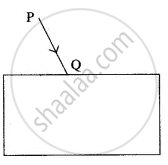
How are the angles ‘i’ and ‘e’ related to each other?
The figure shows two prisms A and B. A monochromatic ray of light PO is incident at the face of the prism A. Complete the diagram to show the path of the ray till it emerges out of the prism B.
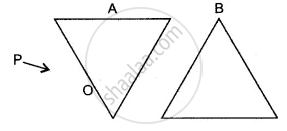
Draw a diagram to show the refraction of a monochromatic light ray through an equilateral prism. On the diagram, label the incident, refracted, and emergent rays. It also indicates the angle of deviation by the letter δ.
The diagram shows the path of a ray of light through a rectangular glass block placed in a liquid of uniform density.

What is the angular, deviation of the emergent ray from the glass block with respect to the incident ray?
Trace a ray of light incident at 30° on a surface if travelling from air to glass. What is the angle of refraction in this case? (R.I. for glass = 3/2).
A ray of light PQ is incident normally on the hypotenuse of a right-angled prism ABC as shown in the diagram given below:

(i) Copy the diagram and complete the path of the ray PQ till it emerges from the prism.
(ii) What is the value of the angle of deviation of the ray?
(iii) Name an instrument where this action of the prism is used.
Consider these indices of refraction: glass: 1.52; air: 1.0003; water: 1.333. Based on the refractive indices of three materials, arrange the speed of light through them in decreasing order.
